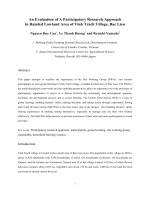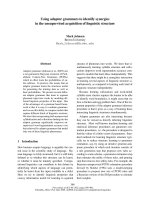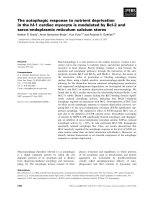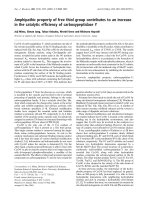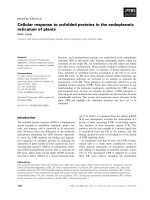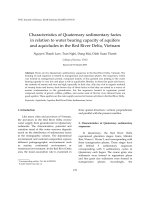Adaptation to saline intrusion in the coastal area of vĩnh châu the vietnamese mekong delta
Bạn đang xem bản rút gọn của tài liệu. Xem và tải ngay bản đầy đủ của tài liệu tại đây (885.14 KB, 9 trang )
VNU Journal of Earth and Environmental Sciences, Vol. 29, No. 3 (2013) 55‐63
Adaptation to Saline Intrusion in the Coastal Area of Vĩnh
Châu, the Vietnamese Mekong Delta
J.E.J. Hagenvoort1, Văn Phạm Đăng Trí*,2 *
1
Land and Water Management Department,
Van Hall Larenstein University of Applied Sciences the Netherlands
2
College of Environment and Natural Resources - Cần Thơ University, Vietnam
Received 12 July 2013
Revised 22 August 2013; Accepted 12 September 2013
Abstract: The extraction of groundwater has increased rapidly over the past decades and forms
one of the main causes of saline water intrusion into the coastal aquifers. Such the intrusion has
been accelerated by the on-going rise of the sea level. Saline intrusion in groundwater in the
Vietnamese Mekong Delta is highly complex as it depends heavily on different factors, including
changes in water supplies (e.g. the magnitude of the annual upstream hydrograph during both the
flood and dry seasons and timing distribution of the annual rainy season) and rising water demands
(e.g. the amount of fresh groundwater extracted for different purposes like domestic, agriculture
and aquaculture use). This article is to provide an insight into current adaptations to increasing
salinity concentration in the groundwater resource in Vĩnh Châu - a coastal district of the Sóc
Trăng province, the Vietnamese Mekong Delta. The existing adaptations to maintain the current
livelihood of local residents were investigated and possible adaptations to sustain such the valuable
fresh groundwater resources were proposed. In fact, adaptations have already taken place by
switching from paddy rice to marine aquaculture over the last decades; however, it is not widely
applicable due to high inputs and great economic risks. No problems were found in the current
situation with farmers who grew upland crops on high sand ridges due to low salinity levels of the
deep groundwater. However, decreases of yield in saline-sensitive agriculture irrigated by
groundwater were experienced in the study area.
Keywords: Saline intrusion, groundwater, climate change, adaptation, coastal area, and Vietnamese
Mekong Delta.
The Vietnamese Mekong Delta (VMD)
covers about 39,000 km2 of fertile alluvial plain
and is home to over 18 million people.*
Groundwater is amongst the important sources
of drinking water for millions, especially those
who live in the coastal areas [1]. The extraction
of deep groundwater has increased rapidly over
the past decades and forms one of the main
causes of saline water intrusion into coastal
aquifers [2]. In fact, the land use change, one of
the main driving factors leading to groundwater
extraction at different extents over time in the
coastal areas of the VMD, happened over the
past 20 years (from paddy rice cultivation to
shrimp farming on the low lying areas). The
changes (initiated by local farmers) protested
______
*
Corresponding author. Tel.: 84-909552092
E-mail:
55
J.E.J. Hagenvoort, V.P.Đ. Trí / VNU Journal of Earth and Environmental Sciences, Vol. 29, No. 3 (2013) 55‐63
56
against the protection of the salinity-controlled
area and the local government allowed
diversification of land use from the year 2000
onwards. The shift from fresh to brackish water
has had great impacts on the ecology and
society in coastal areas [3]. Local farmers who
went for rice farming systems got problems
with the new diversification policy as the fresh
surface-water resources was not sufficent for
single (crop) season. Even thought saline /
brackish aquaculture earned benefits from
changes of water resources, local aquaculture
was not developed effectively as it required
high (financial and technological) input and has
relatively high economical risks. In addition,
incomes of local farmers who went for shrimps
were not secure given constraints of poor
quality of post larval, on-farm technologies and
poor quality of the irrigation network [3].
Saline intrusion into deep groundwater
resources in the VMD is a highly complex
natural process as it depends heavily on
different factors including changes of water
supplies (e.g. the magnitude of the annual
upstream hydrograph during both the flood and
dry seasons and timing distribution of the
annual rainy season) and rising demands (e.g.
the amount of fresh groundwater extracted for
different purposes like domestic, agriculture
and aquaculture use) [4]. Such trend of saline
intrusion into the coastal aquifers becomes even
more serious due to lack of fresh surface-water
resources as a consequence of increasing
demands (especially for agriculture) in the
upstream section of the Mekong River [5].
Scenarios of climate change in the VMD
showed that the annual dry and wet seasons will
become even drier and wetter respectively in
the future [6] (Figure 1). Together with a sea
level rise (up to 30 and 75 cm in 2050 and 2100
y
according to the B2 scenario; [6], the decrease
of rainfall might lead to a significant increase of
saline intrusion in surface-water and
groundwater during the dry season [7].
The Vĩnh Châu district is located in the
coastal zone of the Sóc Trăng province with the
mean land surface elevation of about 1.0 m
above mean sea level (Figure 2). This is a
former salinity-controlled area where rice
farming systems were dominated (Figure 3).
From the year 2000 onwards, farmers protested
against the protection of the salinity-controlled
measures leading to a diversification of local
land use [3]. The new diversification allowed
re-entries of saline water, resulting in a shift
from fresh to brackish surface-water resources.
In fact, over the last 20 years, many areas of
Vĩnh Châu was converted from paddy rice to
marine aquaculture (Figure 3), leading to saline
intrusion in the surface and groundwater
resources [8].
Even though different studies were done to
provide an insight into the groundwater
resources in the VMD (e.g. [7]; Figure 4) and
saline intrusion in groundwater has been
considered seriously over the last decade, little
amount of research was done to quantify the
actual changes of the groundwater quality. To
realize possible adaptations to slow down the
processes and to figure out possible changes in
terms of agriculture and aquaculture to sustain
both the livelihood of local residents and the
ground water resources are actual needs for
further study. This article is to investigate on
the current adaptations to increasing salinity
concentration in the groundwater resource in
Vĩnh Châu and to propose possible adaptations
to sustain such the valuable fresh groundwater
resources.
J.E.J. Hagenvoort, V.P.Đ. Trí / VNU Journal of Earth and Environmental Sciences, Vol. 29, No. 3 (2013) 55‐63
57
Figure 1: Projected rainfall during a year in the future in the VMD according to the B2 scenario (i.e. increased
concerns for environmental and social sustainability).
Figure 2: Digital Elevation Model of the Vĩnh Châu district.
Figure 3: Land use change Vĩnh Châu district from 1990 to 2010.
58
J.E.J. Hagenvoort, V.P.Đ. Trí / VNU Journal of Earth and Environmental Sciences, Vol. 29, No. 3 (2013) 55‐63
Figure 4: North West - South East directed hydro-geological profile of the VMD [7].
2. Methodology
The literature study provides an insight into:
(i) main causes of saline intrusion into both
surface and groundwater; and, (ii) existing
adaptations to adapt to saline intrusion of the
groundwater in the coastal areas of the VMD
over the past 50 years. Information on historical
agricultural land use changes in the study area
was collected to provide insights into saline
intrusion dynamics of the groundwater. In
addition, climate change scenarios were also
studied to project changes of saline intrusion of
groundwater in the future.
Interviews (with local farmers and
authorities) are based on a structured
standardized interview [9] to understand the
actual farming systems and to provide an
insight into the current adaptations to different
salinity levels in both surface and groundwater
resources. In fact, local land use map, Digital
Elevation Model (DEM) and agro-ecological
map (unpublished works done by the Can Tho
University) form a base for selecting farms to
survey. The interviews with local farmrs were
done ranging from sea to inland to provide a
spatial-dependence of the salinity level in the
groundwater. The folowing equipment were
used for measuring the salinity levels of the
groundwater (of 29 pumps) in the field:
- Basic Conductivity Meter, Orion, Model
105 (EC-probe) (calibrated conform the
instruction manual [10]);
- Lab glasses;
- Calibration solution; and,
- Check solution.
The salinity levels of the pumped
groundwater were directly recorded with an
EC-probe (following guidelines for recording
from [11]). Classification of the groundwater
salinity was done by converting from an EC
value (µS/cm) to a chloride concentration
(mg/l) ((Equation 1):
Chloride concentration (mg/l) =
0.31 EC (µS/cm) - 170.03
(Equation 1) [12]
J.E.J. Hagenvoort, V.P.Đ. Trí / VNU Journal of Earth and Environmental Sciences, Vol. 29, No. 3 (2013) 55‐63
3. Results
3.1. Current salinity levels of deep groundwater
along hydro-geological profiles in Vĩnh Châu
The salinity measurements only take place
for the deep groundwater with an average depth
of 110 m. In fact, depths of the groundwater
pumps are between 50 - 200 meters, which
concerns three different aquifers, including:
- One groundwater pump is located in the
Upper Pleistocene aquifer. This aquifer starts at
approximately 40 m below the land surface and
has a thickness of 20m. The salinity
measurement showed an EC value of 2.139
µS/cm (494 Cl-mg/l), the greatest amongst all
29 measurements.
- The Upper-Middle Pleistocene could be
found at a depth of approximately 80 m, with a
59
thickness of 55 m and low saline concentration
in groundwater [7]. 26 out of 29 measured
groundwater pumps are located in this layer.
The results of the salinity measurements in this
aquifer show a very divers pattern, with EC
values between the 1.050 - 1.600 µS/cm.
- The Lower Pleistocene aquifer starts at a
depth of 135 meters and ends at approximately
220 meters and is commonly used for
exploitation. 2 out of 29 groundwater pumps
have a depth that reaches this aquifer.
Figure 5a, b, c and d present the salinity
concentration (in the groundwater) changes
from coast to inland. Segment lines (including
sub-lines) (Figure 6) show an increase of
salinity further inland.
d
Figure 5: Salinity changes groundwater in the coastal zone - Segment line 1 (A), Segment line 2, subline 1 (B),
Segment line 2, subline 2 (C) and Segment line 2, subline 3 (D).
J.E.J. Hagenvoort, V.P.Đ. Trí / VNU Journal of Earth and Environmental Sciences, Vol. 29, No. 3 (2013) 55‐63
60
Figure 6: Locations salinity level measurements with different segment lines.
Figure 7 presents the current salinity levels
(EC values) of the groundwater with reference
to the pump depths. The average chloride
concentration was about the 246 mg Cl-/l, with
a maximum of 495 mg Cl-/l (brackish) and
minimum of 159 mg Cl-/l (mild brackish). The
deep groundwater was classified as light
brackish to brackish. The EC values of the
pumps located near the coast of Vĩnh Châu
were lower than the values further inland.
3.2. Analysis of salt tolerance for upland crop
and aquaculture
Deep groundwater was used for
irrigating upland crops during the dry seasons.
While there was no significant yield reduction
in the current situation for cabbage, chilli and
sweet corn, onions were under threats of the
salinity of groundwater. In fact, according to
FAO (1999) the threshold EC of onion occurs
at 1.200 µS/cm with a slope of 16% per dS/m
while the irrigation water used for onions has a
range of 1.200 –1.500 µS/cm. In addition,
g
thresholds of EC for chilly, corn and cabbage
are 1.500 µS/cm, 1.700 µS/cm and 1.800
µS/cm, respectively [14].
Shrimp farming increased over the past 20
years (Figure 3). The Black Tiger shrimp
(Penaeus monodon) and Artemia Franciscana
were cultivated in Vĩnh Châu with the
combination use of fresh groundwater and
sea/river water. The ideal salinity range of
Black Tiger shrimps ranges between the 10.000
- 30.000 mg/l [15]. When the salinity becomes
too high the shrimps grow slowly but are still
healthy and resistant to diseases. If the level of
salinity becomes too low, the shrimp shell
becomes weak and prone to diseases [15].
Problems with salinity levels could occur when
sea/river water was mixed with groundwater
without a proper application of technology and
knowledge of shrimp farmers in Vĩnh Châu.
Artemia forms a ideal adaptation measure due
to high salinity tolerances [16].
J.E.J. Hagenvoort, V.P.Đ. Trí / VNU Journal of Earth and Environmental Sciences, Vol. 29, No. 3 (2013) 55‐63
61
Figure 7: EC values based on different depths Vĩnh Châu district.
4. Discussions and conclusions
The obtained results of the salinity
measurements of the deep groundwater showed
that salinity concentration increases from the
coast to inland. Analyses of the hydrogeology
showed that each aquifer has different qualities
depending on
the depth and rather unpredictable; further studies are needed to get an
overview on groundwater quality distribution in
the VMD.
Acceptable
ranges
of
salinity
of
groundwater depend strongly on the crop choice
of local farmers. Groundwater for agriculture
use is classified as fresh until 150 mg Cl-/l [17].
Further research is needed to understand the
complex processes of saline intrusion into deep
groundwater.
Farmers with land on high sand ridges often
practiced upland crops systems (Figure 2).
Deep groundwater is used for irrigation of the
upland crops. In the current situation yield
reduction takes place for the cultivation of
onions (with the range between 0-5%). If the
salinization of the groundwater increases in the
future due to climate change predictions, local
farmers with upland crops might face problems
of yield reduction [18].
Based on this study, a number of key
lessons can be identified for the further
considerations:
- The salinity level of the deep groundwater
that is used for irrigating agriculture (especially
upland crops) and mixing with sea water for
aquaculture does not cause yield reduction in
the current situation. In the future, with possible
impacts of climate change and sea level rise,
rising salinity level of the deep groundwater
may introduce great threats to agriculture;
- As Vĩnh Châu faces directly the East Sea
and marine aquaculture is one of the main
sources of income, saline intrusion of the
groundwater is not a major problem
constraining livelihood of local residents.
However, areas further inland with less favorite
for saline environment, saline intrusion in the
surface-water resources may lead to more
constraints for agriculture, resulting in
groundwater extraction at greater extents;
- According to staffs of Department of
Environment and Natural Resources in Vĩnh
Châu (personal communication, 2013) apart
from deep groundwater and fresh surface-water
resources, collecting shallow groundwater and
rainfall might help sustain livelihood of local
residens living in the coastal areas of the VMD
62
J.E.J. Hagenvoort, V.P.Đ. Trí / VNU Journal of Earth and Environmental Sciences, Vol. 29, No. 3 (2013) 55‐63
(like Vĩnh Châu). Even though local farmers
rely on the deep groundwater, other water
sources like shallow groundwater and rainwater
could ease the constraints and make farming
systems more sustainable;
- The mixed shrimp-mangrove systems
could form a suitable adaptation strategy due to
the advantages of integrating ecology and
agriculture [19]. Such system is reachable to
small-scale and family-based operations.
Further research on how farmers implement this
system is an actual need.
References
[1] IUCN. Groundwater in the mekong delta. MeKong
Water Dialogues 2011:1-12.
[2] Abd-Elhmid HF, Javadi AA. An Investigation into
Control of Saltwater Intrusion Considering the Effects
of Climate Change and Sea Level Rise. School of
Engineering, Computing and Mathematics, University
of Exceter 2008:4-7.
[3] Kakonen M. Mekong Delta at the Crossroads: More
Control or Adaptation? Ambio 2008;37:205-12.
[4] Deltares, Delta Alliance. Vietnam-Netherlands Mekong
Delta Masterplan project Mekong delta water resources
assesment studies. Viet nam-Neetherlands Mekong
Delta Masterplan Project 2011:1-68.
[5] Mekong River Commission For Sustainable
Development. Saltwater intrusion in the mekong river
delta 2001:1-9.
[6] MONRE. Climate change and sea level rise scenarios
for Vietnam 2009.
d
[7] Wagner F, Tran VB, Renaud FG. Chapter 7
Groundwater resources in the Mekong Delta:
Availability, Utilization and Risks. In: Renaud FG,
Kuenzer C, editors. The Mekong Delta System,
Dordrecht: Springer Netherlands; 2012, p. 201-20.
[8] Nhan DK, Be N Van, Trung NH. Chapter 4: Water Use
and Competition in the Mekong Delta, Vietnam. 2008.
[9] Crawford IM. Personal Interview. Marketing Research
and Information Systems, 1997.
[10] Thermo Electron Corporation. Orion Aplus Advanced
Conductivity Meters. 2003.
[11] Department of Environment and Primary Industries.
Farming and Management 2011.
[12] Essink GO, Louw P de, Stevens S, Veen B de, Prevo C,
Marconi V, et al. No Title. TNO Bouw En Ondergrond
2009:106.
[13] FAO. Agricultural drainage water management in arid
and semi-arid areas. Food and Agriculture Organization,
1999.
[14] FAO. Determine the amount of water needed for
land preparation. 1989.
[15] Pushparajan N, Soundarapandian P. Recent Farming of
Marine Black Tiger Shrimp , Penaeus Monodon (
Fabricius ) in South India. African Jounrnal of Basic &
Applied Sciences 2010;2:33–6.
[16] Stottrup JG, Mcevoy L. Live Feeds in Marine
Aquaculture. 2003.
[17] Essink GO, Louw P de, Vliet M van, Baaren E van,
Goes B, Prevo C, et al. Zoet-zout studie Provincie
Flevoland. TNO Bouw En Ondergrond 2008:118.
[18] Grattan S. Irrigation Water Salinity and Crop
Production. University of California ANR 2002:8066.
[19] Bridson P. Black tiger shrimp Ca Mau Province of
Southern Vietnam and other areas of Southeast Asia.
Monterey Bay Aquarium - Seafood Watch: 2013.
Thích ứng với xâm nhập mặn ở vùng ven biển Vĩnh Châu,
Đồng bằng Sơng Cửu Long
J.E.J. Hagenvoort1, Văn Phạm Đăng Trí*,2 *
1
Bộ Môn Quản Lý Đất và Nước - Đại Học Khoa Học Ứng Dụng Van Hall Larenstein, Hà Lan
2
Khoa Môi trường và Tài nguyên Thiên nhiên - Đại học Cần Thơ, Việt Nam
Tóm tắt: Việc khai thác nước dưới đất để phục vụ cho các hoạt động sinh hoạt hằng ngày cũng
như các hoạt động sản xuất nông nghiệp và thủy sản của người dân vùng ven biển đã gia tăng đáng kể
J.E.J. Hagenvoort, V.P.Đ. Trí / VNU Journal of Earth and Environmental Sciences, Vol. 29, No. 3 (2013) 55‐63
63
trong những năm gần đây; đây là một trong những nguyên nhân dẫn đến sự xâm nhập mặn ở các tầng
nước dưới đất ở vùng ven biển. Ngồi ra, tình trạng nhiễm mặn cũng được dự báo là sẽ tăng lên đặc
biệt là trong điều kiện mực nước biển dâng trong tương lai. Tình trạng xâm nhập mặn vào các tầng
nước dưới đất ở Đồng Bằng Sông Cửu Long (ĐBSCL) diễn ra khá phức tạp và phụ thuộc vào nhiều
yếu tố khác nhau như, suy giảm nguồn nước cấp (suy giảm nguồn nước ở thượng nguồn sông
Mekong) và tăng nhu cầu sử dụng nước (nước sinh hoạt hằng ngày trong gia đình cũng như nhu cầu
nước cho các hoạt động nông nghiệp và thủy sản). Bài báo này tập trung tìm hiểu những giải pháp
thích ứng hiện có ở vùng ven biển Vĩnh Châu, tỉnh Sóc Trăng, ĐBSCL trong điều kiện xâm nhập mặn
nguồn tài nguyên nước dưới đất đang diễn ra ngày càng phức tạp. Những giải pháp thích ứng hiện có
được khảo sát nhằm đánh giá nhằm tính ổn định trong sinh kế của cộng đồng dân cư địa phương (liên
quan đến hoạt động khai thác nước dưới đất); bên cạnh đó, một số giải pháp thích ứng cũng được đề
xuất nhằm hổ trợ sự phát triển bền vững của vùng. Theo kết quả khảo sát, một số chiến lược thích ứng
đã được áp dụng ở địa phương trong những năm qua (ví dụ: chuyển từ các hoạt động nông nghiệp
sang nuôi trồng thủy sản); tuy nhiên, việc chuyển đổi cơ cấu canh tác (từ nông nghiệp sang thủy sản)
cũng đã gặp một số khó khăn do nhu cầu đầu tư cũng như rủi ro (về lợi nhuận) từ các hoạt động nuôi
trồng thủy sản là khá cao. Ngoài ra, theo kết quả khảo sát, hiện tại người dân trồng màu trên các giồng
cát trong vùng nghiên cứu khơng gặp phải những khó khăn đáng kể (về nguồn tài nguyên nước) do
nồng độ muối trong nước dưới đất khơng cao. Tuy nhiên, nhìn chung, các hoạt động canh tác nơng
nghiệp đã có xu hướng bị ảnh hưởng tiêu cực do tình trạng nguồn nước dưới đất trong vùng nghiên
cứu bị nhiễm mặn.
Từ khóa: Xâm nhập mặn, nước dưới đất, biến đổi khí hậu, thích ứng, vùng ven biển, và Đồng Bằng Sông
Cửu Long.
